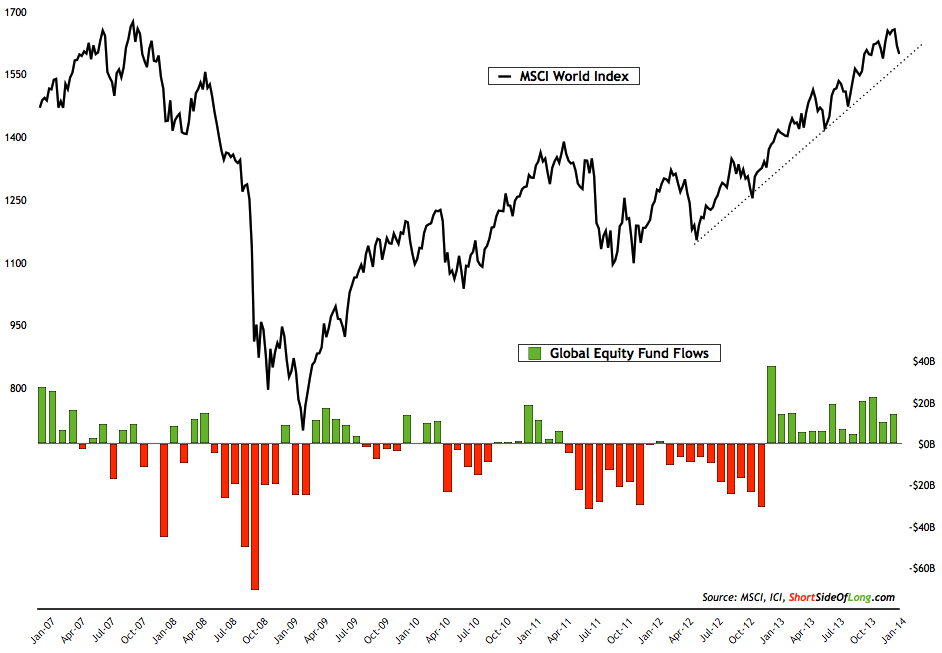Five Fund Flow Charts Every Japanese Stock Investor Should See
Post on: 19 Май, 2015 No Comment

We recently detailed the critical charts on the progression of ‘Abenomics’ but perhaps more important than the total lack of positive economic ‘change’ — due, we are sure, to not-enough-time or not-enough-money — is the drastic change in investor positioning in Japanese equities .
The unprecedented volatility in JGBs of late suggests that Kuroda-Abe’s utopia of an inflation-driving money-printing exuberance combined with well-managed and controlled interest rates is unlikely. Some have argued that JGB investors will rotate to US Treasuries (higher rates and non-JPY diversification) but as we noted here, perhaps that will be delayed as front-running the BoJ (and selling down other assets to meet margin requirements may be easier — in the game-theoretic sense).
But that does not seemed to have stopped the world speculating on what moar free money will do to the nominal price of Japanese stocks.
Japanese stocks are an alternative for Japanese investors who sell their JGB holdings to the BoJ, especially those not constrained by asset-liability duration matching. Indeed, the hedge fund community, leveraged investors, are also speculating that that the BoJ actions will boost Japanese equities. The number of buys minus sells across all margin trading in the Tokyo Stock Exchange, for which we have weekly data, rose sharply after the BoJ meeting to well above the recent years’ range .
The gap between buys and sells, currently at 3.9mn shares, is the highest since June 2006. The absolute peak was at 5.3mn in January 2006. The second highest was at 5.2mn shares in March 1990. The chart below suggests that peaks in this position indicator were subsequently followed by market corrections. suggesting this indicator should be used as a contrarian indicator but one should wait for signs of peaking first before he or she turns negative on Japanese equities.
But this stretch is also indicated in CFTC Speculative positioning in Nikkei 225 futures — with leveraged long investors at record highs.
And its not just the Japanese, foreign buyers are herding lemming-like into the momentum-based surge. Foreign buying has averaged around ¥1tr or $10bn per month since last October. It rose to $17bn in March and picked up further following the BoJ decision last week. Although not very large in absolute amounts, foreign buying of Japanese equities tends to trigger further equity buying by domestic investors.
Indeed, as is clear in the chart above, since October, Japanese investors have been selling foreign equities to invest to their domestic market. This selling of foreign equities reached unprecedented levels in March at $17bn.
The flow indicators above are useful in gauging equity and bond positions but the implication for the JPY is less clear, as we do not know whether investors have currency hedged their exposures or not. To track JPY positioning we use the spec positions as reported by the CFTC and the beta of currency hedge funds to the JPY.
By these measures, spec shorts in the JPY remain very short by historical standards while currency funds are only slightly short. But the yen weakness since the beginning of the year has not only been driven by overseas investors but also domestic Japanese investors. Japanese FX margin traders, typically retails investors (so-called Mrs. Watanabe), have been steadily building their JPY shorts from almost zero at the beginning of the year to ¥7.7tr as of April 3rd. In a way they are only 25% away from the historical peak of ¥10tr of JPY shorts seen in July 2011.
There is a comfort that comes from being on the same side as the consensus. Group-speak and confirmation bias trump any cognition. But when everyone — everyone — is on the same side of the boat, in a trade-that-just-can’t-lose, is it better to be first out with a life-saver or last out?
Charts: JPMorgan














